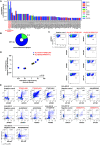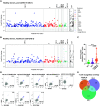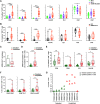SARS-CoV-2 genome-wide T cell epitope mapping reveals immunodominance and substantial CD8+ T cell activation in COVID-19 patients
- PMID: 33853928
- PMCID: PMC8139428
- DOI: 10.1126/sciimmunol.abf7550
SARS-CoV-2 genome-wide T cell epitope mapping reveals immunodominance and substantial CD8+ T cell activation in COVID-19 patients
Abstract
T cells are important for effective viral clearance, elimination of virus-infected cells and long-term disease protection. To examine the full-spectrum of CD8+ T cell immunity in COVID-19, we experimentally evaluated 3141 major histocompatibility (MHC) class I-binding peptides covering the complete SARS-CoV-2 genome. Using DNA-barcoded peptide-MHC complex (pMHC) multimers combined with a T cell phenotype panel, we report a comprehensive list of 122 immunogenic and a subset of immunodominant SARS-CoV-2 T cell epitopes. Substantial CD8+ T cell recognition was observed in COVID-19 patients, with up to 27% of all CD8+ lymphocytes interacting with SARS-CoV-2-derived epitopes. Most immunogenic regions were derived from open reading frame (ORF) 1 and ORF3, with ORF1 containing most of the immunodominant epitopes. CD8+ T cell recognition of lower affinity was also observed in healthy donors toward SARS-CoV-2-derived epitopes. This pre-existing T cell recognition signature was partially overlapping with the epitope landscape observed in COVID-19 patients and may drive the further expansion of T cell responses to SARS-CoV-2 infection. Importantly the phenotype of the SARS-CoV-2-specific CD8+ T cells, revealed a strong T cell activation in COVID-19 patients, while minimal T cell activation was seen in healthy individuals. We found that patients with severe disease displayed significantly larger SARS-CoV-2-specific T cell populations compared to patients with mild diseases and these T cells displayed a robust activation profile. These results further our understanding of T cell immunity to SARS-CoV-2 infection and hypothesize that strong antigen-specific T cell responses are associated with different disease outcomes.
Copyright © 2021, American Association for the Advancement of Science.
Figures





References
-
- Coronavirus disease (COVID-19), (available at https://www.who.int/emergencies/diseases/novel-coronavirus-2019).
-
- Seow J., Graham C., Merrick B., Acors S., Pickering S., Steel K. J. A., Hemmings O., OByrne A., Kouphou N., Galao R. P., Betancor G., Wilson H. D., Signell A. W., Winstone H., Kerridge C., Huettner I., Jimenez-Guardeo J. M., Lista M. J., Temperton N., Snell L. B., Bisnauthsing K., Moore A., Green A., Martinez L., Stokes B., Honey J., Izquierdo-Barras A., Arbane G., Patel A., Tan M. K. I., OConnell L., OHara G., MacMahon E., Douthwaite S., Nebbia G., Batra R., Martinez-Nunez R., Shankar-Hari M., Edgeworth J. D., Neil S. J. D., Malim M. H., Doores K. J., Longitudinal observation and decline of neutralizing antibody responses in the three months following SARS-CoV-2 infection in humans. Nat. Microbiol. 5, 1598–1607. (2020). 10.1038/s41564-020-00813-8 - DOI - PMC - PubMed
-
- Bonifacius A., Tischer-Zimmermann S., Dragon A. C., Gussarow D., Vogel A., Krettek U., Gdecke N., Yilmaz M., Kraft A. R. M., Hoeper M. M., Pink I., Schmidt J. J., Li Y., Welte T., Maecker-Kolhoff B., Martens J., Berger M. M., Lobenwein C., Stankov M. V., Cornberg M., David S., Behrens G. M. N., Witzke O., Blasczyk R., Eiz-Vesper B., COVID-19 immune signatures reveal stable antiviral Tcell function despite declining humoral responses. Immunity 54, 340–354.e6. (2021). 10.1016/j.immuni.2021.01.008 - DOI - PMC - PubMed
Publication types
MeSH terms
Substances
LinkOut - more resources
Full Text Sources
Other Literature Sources
Medical
Molecular Biology Databases
Research Materials
Miscellaneous

